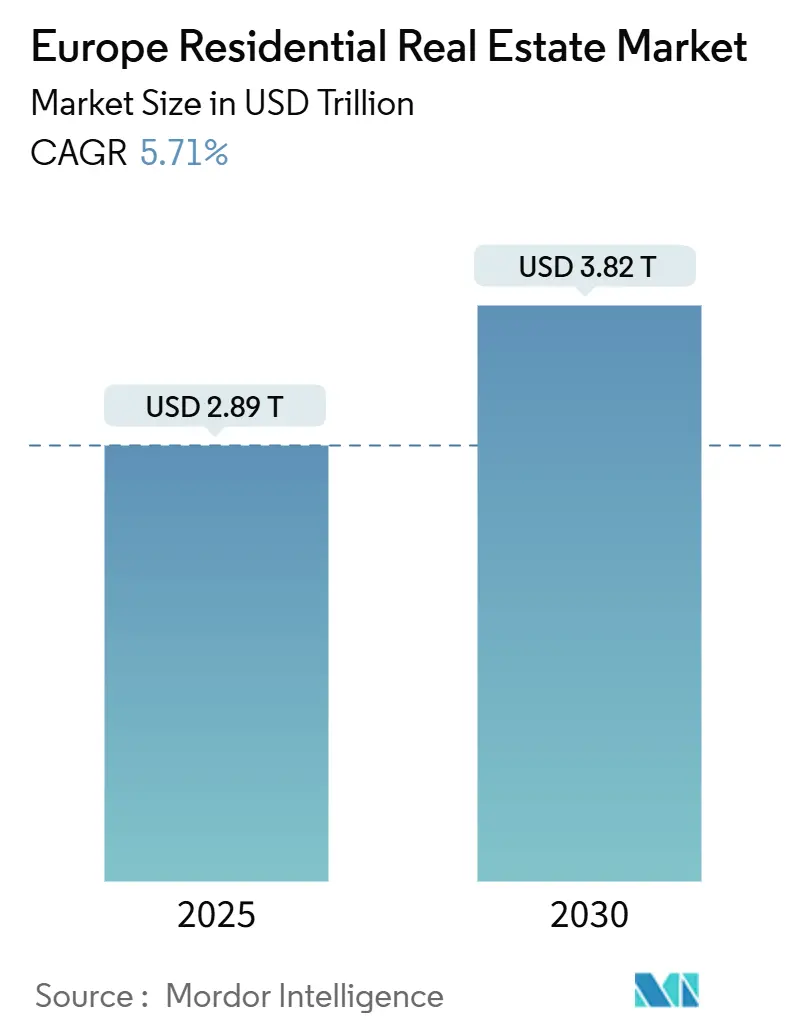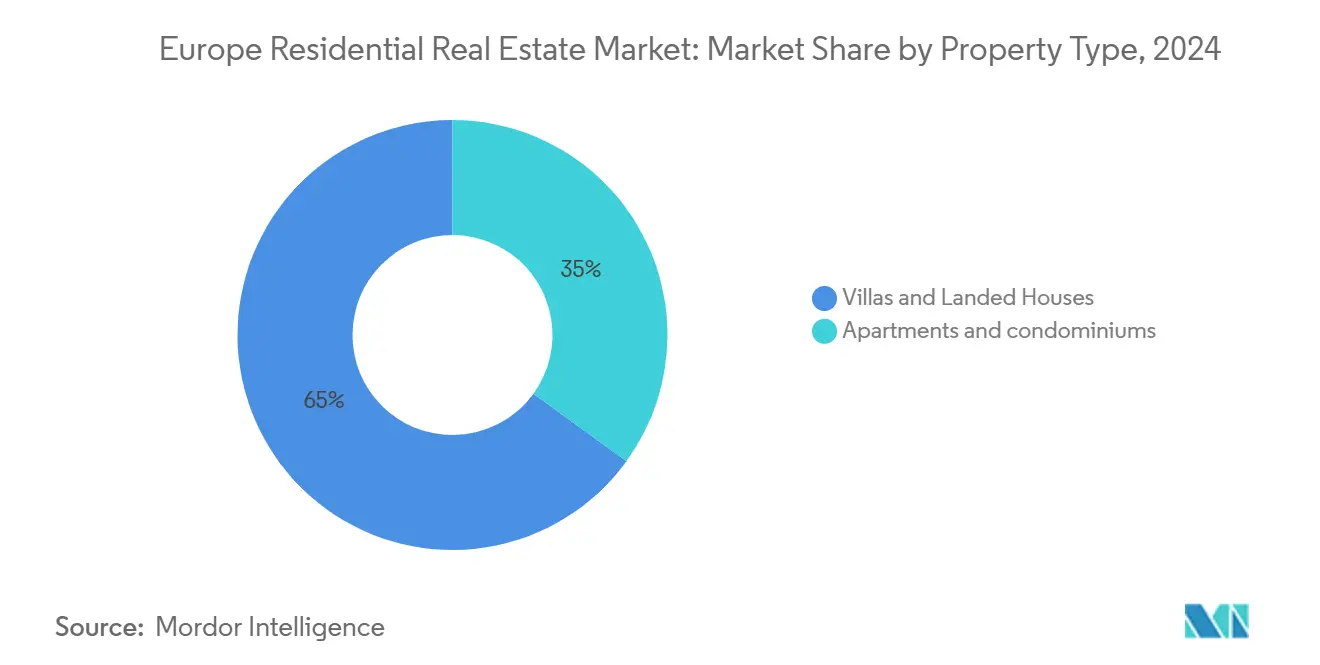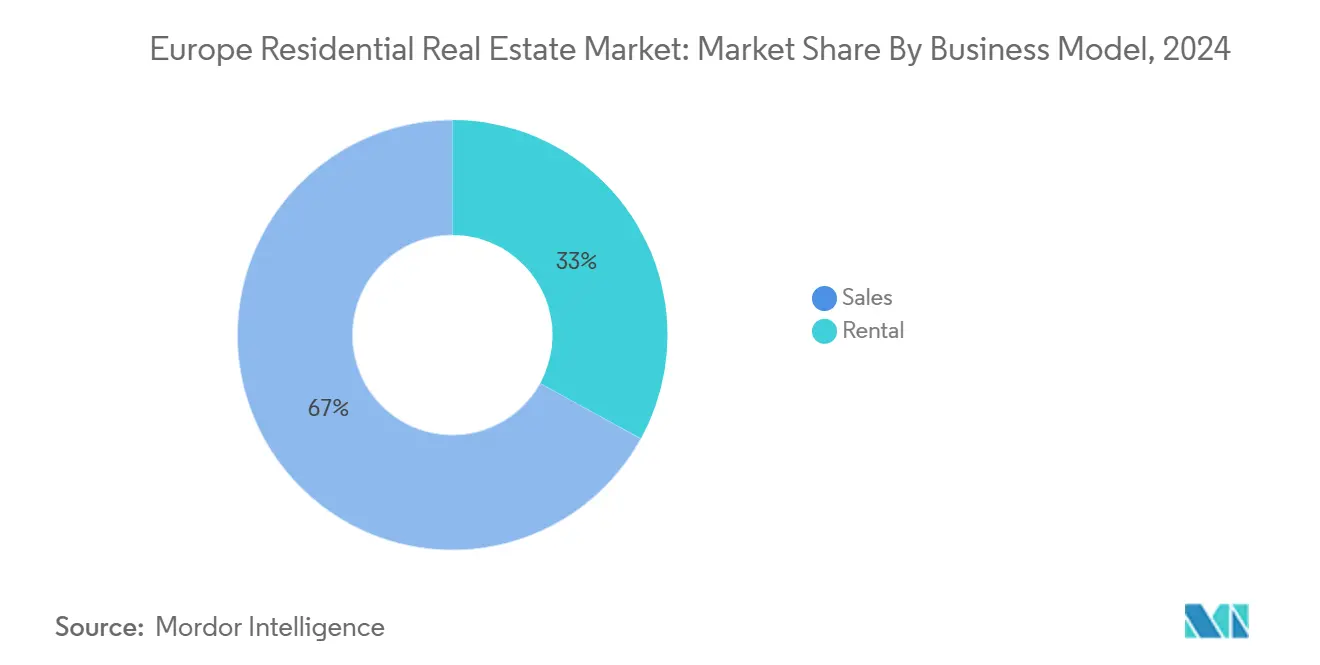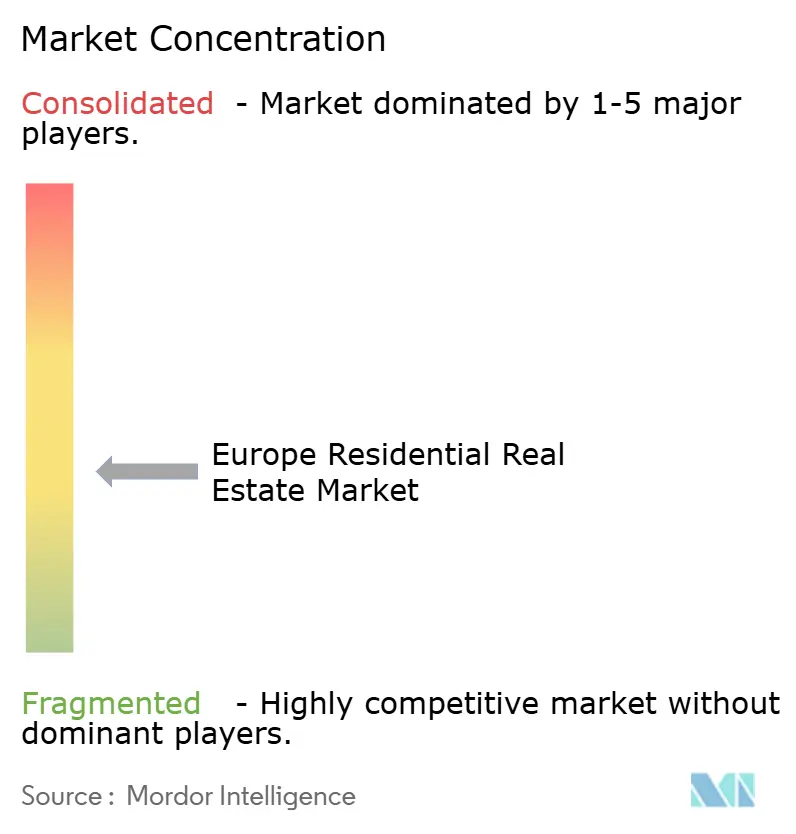
Europe Residential Real Estate Market Analysis by Mordor Intelligence
The Europe residential real estate market size is valued at USD 2.89 trillion in 2025 and is forecast to expand to USD 3.82 trillion by 2030, reflecting a 5.71% CAGR. This trajectory illustrates the European real estate market’s capacity to absorb changing monetary policies, stricter energy regulations, and shifting demographic patterns. Demand is gravitating toward professionally managed rental platforms as institutional investors prioritise predictable cash flows, while supply bottlenecks in major conurbations keep overall vacancy below 3% in many gateway cities. Policy-driven retrofitting mandates under the EU Green Deal are reshaping construction pipelines, and secondary sales continue to dominate because Europe’s housing inventory skews older. Digital-nomad visa programmes, single-person household growth, and the rise of purpose-built rental communities together underpin a balanced yet resilient expansion path for the European real estate market
Key Report Takeaways
- By property type, Villas and Landed Houses led with 65% of the Europe residential real estate market share in 2024, while Apartments and Condominiums are projected to grow at a 5.96% CAGR through 2030.
- By price band, the Mid-Market segment accounted for 46% of the Europe residential real estate market size in 2024, whereas the Affordable tier is advancing at a 5.90% CAGR to 2030.
- By business model, Sales dominated 67% of the Europe residential real estate market in 2024, yet the Rental model records the highest growth at 6.07% CAGR through 2030.
- By mode of sale, Secondary transactions captured 90% share of the Europe residential real estate market size in 2024; the Primary market is expanding at a 6.00% CAGR during the forecast period.
- By geography, Germany held 22% of the Europe residential real estate market share in 2024, while the Netherlands is the fastest-growing country at 6.14% CAGR to 2030.
Europe Residential Real Estate Market Trends and Insights
Drivers Impact Analysis
| Driver | (~) % Impact on CAGR Forecast | Geographic Relevance | Impact Timeline |
|---|---|---|---|
| EU Green Deal incentives for deep retrofits | +1.2% | Germany, France, Netherlands | Long term (≥ 4 years) |
| Growth of single-person households | +0.9% | Urban Europe, especially Germany, UK, France | Medium term (2-4 years) |
| Cross-border private-equity inflows into build-to-rent | +0.8% | UK, Germany, Netherlands | Medium term (2-4 years) |
| Institutional move toward purpose-built rental | +0.7% | Northern and Central Europe | Medium term (2-4 years) |
| Ageing population driving senior housing | +0.5% | Germany, Sweden, Denmark, Norway | Long term (≥ 4 years) |
| Digital-nomad visa adoption | +0.4% | Spain, Portugal, Italy, Greece | Short term (≤ 2 years) |
| Source: Mordor Intelligence | |||
Surge in Cross-Border Private-Equity Inflows Targeting European Build-to-Rent Portfolios
Cross-border private equity tripled its residential spending over the past decade, underpinning a structural swing toward large-scale build-to-rent assets. Liquidity from global pension and sovereign-wealth funds severs the traditional wage-to-price tether by injecting capital more sensitive to interest-rate cycles than household income. The United Kingdom reclaimed the top spot for cross-border allocations, with 84% of surveyed investors planning exposure following currency readjustments. Build-to-rent strategies now account for 32% of institutional “living-sector” allocations, eclipsing industrial logistics. Stable cash flows, inflation-linked leases, and embedded refurbishment potential make these portfolios a hedge against office-market volatility. The resulting depth of capital supports construction financing despite higher funding costs, cushioning the European real estate market against rate-driven slowdowns.
EU Green Deal Incentives Accelerating Deep-Retrofit Demand Across Housing Stock
The revised Energy Performance of Buildings Directive mandates all residential stock to reach at least class E by 2030, pushing 85% of pre-2000 dwellings into renovation pipelines[1]European Commission, “Energy Performance of Buildings Directive (Recast),” European Commission, ec.europa.eu. Member States must issue “renovation passports,” coordinate one-stop advisory shops, and phase out fossil-fuel boilers by 2035. Zero-emission targets for new builds after 2028 create a dual demand surge: upgrading legacy assets and delivering energy-positive developments. The policy injects a EUR 86 billion funding gap for 2025-2027 that lenders are filling through sustainability-linked mortgages and green bonds. Properties rated A or B now trade at premiums of up to 12% in core cities, incentivising landlords to accelerate cap-ex schedules. For the European real estate market, the directive anchors long-dated refurbishment cash flows and rewards forward-thinking owners with valuation upside.
Rise in Single-Person Households Fuelling Multi-Family Apartment Uptake in Urban Cores
Single-person households surpassed 35% of total European households in 2024, lifting demand for compact apartments close to employment clusters. Vonovia recorded a 4.3% organic rent increase and a vacancy rate of 2.1% across its German portfolio, underscoring the absorption pace. Urban zoning reforms prioritise density, and developers now integrate co-working pods and communal amenities to cater for hybrid work lifestyles. Residential investment volumes climbed 25% year on year, doubling the sector’s share of total real-estate deals to 21%. Prime residential rents are set to rise faster than inflation through 2029, reflecting limited supply of energy-efficient urban stock. This demographic pivot enhances the relevance of multi-family assets within the European real estate market and strengthens rent-indexation bargaining power.
Digital-Nomad Visa Adoption Boosting Southern-Europe Second-Home Purchases
Spain’s digital-nomad visa is driving a 5.9% house-price gain forecast for 2025, with one-third of municipalities expecting double-digit appreciation. Affordability pressures intensify as median households need 7.5 years of income for an average home, up from 7.2 years in 2024. Portugal and Italy echo the pattern as high-earning remote workers seek lifestyle locations with robust fibre networks. Regions such as Lisbon and Valencia experiment with limits on short-term rentals to shield local tenants. The phenomenon channels fresh equity into coastal stock and hotel-to-residential conversions, adding heterogeneity to the European real estate market’s regional cycle.
Restraints Impact Analysis
| Restraint | (~) % Impact on CAGR Forecast | Geographic Relevance | Impact Timeline |
|---|---|---|---|
| ECB rate hikes widening mortgage affordability gap | -1.1% | Eurozone-wide | Short term (≤ 2 years) |
| Stricter EPC rules inflating landlord cap-ex | -0.6% | EU-wide, older stock | Medium term (2-4 years) |
| Southern-Europe wage stagnation limiting first-time affordability | -0.4% | Spain, Italy, Portugal, Greece | Medium term (2-4 years) |
| Urban growth boundaries restricting green-field land supply | -0.3% | Core metropolitan areas | Long term (≥ 4 years) |
| Source: Mordor Intelligence | |||
ECB Rate Hikes Widening Mortgage Affordability Gap
The abrupt end to ultra-low financing saw average French mortgage rates peak at 3.63% before easing to 2.75% by late-2024, yet transactions still fell 35.6% from 2021 levels. ECB analysis classifies over 80% of euro-area housing markets as overvalued, exposing borrowers to income-stress risks if rates rebound[2]European Central Bank, “Housing Market Developments in the Euro Area,” European Central Bank, ecb.europa.eu. Norwegian variable mortgages stand near 5.56%, dampening purchasing power despite a projected base-rate cut in 2025. Younger buyers face stricter loan-to-income caps and shorter amortisation periods, extending the time needed to build down payments. Although new-build supply lags, tighter credit keeps the European real estate market’s owner-occupier demand subdued in the short run.
Stricter EPC Rules Inflating Landlord Cap-Ex
Non-residential assets must reach class F by 2027 and class E by 2030, while residential properties follow a staggered path to 2033[3]European Parliament, “Directive on Energy Performance of Buildings,” European Parliament, europarl.europa.eu. Compliance costs are escalating: triple-glazed windows, heat-pump installations, and façade insulation often exceed EUR 450 per square metre for pre-1970 buildings. Austria’s tenancy law limits renovation recapture without tenant consent, delaying upgrades. Smaller landlords exit, selling to institutional aggregators capable of bulk-financing retrofit programmes. Construction labour shortages compound timelines as the sector already operates near full capacity. These cap-ex burdens temper rental stock growth and weigh on the European real estate market’s near-term supply elasticity.
Segment Analysis
By Property Type: Apartments Accelerate Urban Densification and Sustainability
Villas and Landed Houses held 65% of the Europe residential real estate market share in 2024 while Apartments and Condominiums are set to record a 5.96% CAGR through 2030. Institutional interest in scalable multi-family assets concentrates capital and accelerates construction pipelines, while wooden-hybrid designs trim embodied carbon and shorten build times.
The apartment surge is reinforced by ESG-linked loan pricing that rewards energy-efficient designs, helping sponsors secure debt at spreads 25–35 basis points tighter than less efficient stock. Villas remain attractive to families seeking outdoor space, and peripheral transit upgrades preserve demand for detached units. Yet the European real estate market size tied to urban apartments is rising as demographic trends favour compact living and as municipalities unlock brownfield sites for higher-density programmes.

Note: Segment shares of all individual segments available upon report purchase
By Price Band: Affordable Housing Segment Receives Strong Policy Backing
Mid-Market transactions represented 46% of the Europe residential real estate market market size in 2024, yet the Affordable tier is projected to expand at a 5.90% CAGR on the back of public-private partnerships and zoning incentives. Governments tap institutional funds via long-income leases, offering inflation-indexed rents backed by social-housing agencies.
Greystar and ABP’s EUR 420 million Essential Housing venture illustrates capital appetite for below-market-rent assets, delivering yields that compress only modestly compared with prime market-rate stock. Luxury remains resilient in global-city cores but captures a small volume share. The policy push toward affordability thus reshapes pipeline composition and injects social objectives into the European real estate market.
By Business Model: Rental Platforms Secure Growing Institutional Capital Flows
Sales retained 67% share in 2024 in Europe residential real estate market, yet Rental model are projected to grow at 6.07% CAGR as households value flexibility and as down-payment hurdles rise. Build-to-Rent operators integrate IoT sensors for predictive maintenance, cutting operating ratios to around 25% of gross rent.
Large developers such as Berkeley pivot into rental to diversify earnings and capture lifetime customer value. Benchmark data show European real estate market rents rising 3.2% annually through 2029, exceeding CPI and widening the spread over fixed-income yields. Sales activity remains anchored by cultural preferences, but rental’s scaled management and predictable returns attract insurers and sovereign funds, shifting the market’s centre of gravity.

Note: Segment shares of all individual segments available upon report purchase
By Mode of Sale: Primary Market Expands to Alleviate Supply Shortages
Secondary sales contributed 90% of transactions in 2024, leveraging Europe’s deep existing stock and transparent registries. However, the primary market is forecast to advance at a 6.00% CAGR as governments target supply gaps and streamline permitting. Vertical mixed-use schemes anchor regeneration zones, offering offices, retail, and 2,000-plus residential units in a single planning phase.
Developers employ timber-modular systems to accelerate delivery, meeting high-performance energy codes while reducing onsite labour. Mortgage guaranty schemes for first-time buyers of new builds further stimulate absorption. These dynamics gradually rebalance inventories and strengthen the forward pipeline within the European real estate market.
Geography Analysis
Germany secured 22% of 2024 value, supported by Vonovia’s EUR 2.6 billion adjusted 2024 EBITDA and a plan for 3,000 new units in 2025. Federal tax reforms permitting faster depreciation enhance buy-to-let returns, and rent caps in Berlin temper volatility.
The Netherlands, growing at a 6.14% CAGR, benefits from clear spatial-planning policies and institutional appetite, epitomised by TPG Angelo Gordon’s EUR 695 million purchase of 3,000 rentals. Governmental supply targets of 900,000 homes by 2030 and rent-hike ceilings below wage growth keep demand stoked.
The United Kingdom remains Europe’s principal cross-border capital magnet, as weaker sterling magnifies yield pick-ups versus US core assets. Nordic countries emerge as stable growth nodes; Sweden’s SEK 138.5 billion 2024 turnover and Norway’s forecast 9.3–10% 2025 price climb reflect supportive macro conditions. Southern Europe records a bifurcated pattern: Spain enjoys 5.9% projected 2025 appreciation on digital-nomad inflows, while wage stagnation restrains Italian absorption. This mosaic underscores the European real estate market’s region-specific cycles yet unified investor narrative around ESG and demographic resilience.
Competitive Landscape
The European residential real estate market is moderately competitive, with consolidation favoring larger, diversified platforms. The merger of Aedifica and Cofinimmo has birthed a healthcare-focused REIT with a pan-European presence, enhancing its leverage with contractors and lenders. Meanwhile, Blackstone's decade-long commitment of USD 500 billion to Europe underscores a significant appetite for distressed debt, rental housing, and logistics.
Operational differentiation now hinges on technology and sustainability. Catella’s partnership with Sopra Steria embeds AI-driven portfolio analytics across 12 countries, trimming cap-ex misallocation and enhancing tenant service. Vonovia earmarks EUR 2 billion by 2028 to reach net-zero carbon intensity, reinforcing its market-leader status and setting ESG benchmarks peers must follow.
Financial-services consolidation also influences competitive dynamics. BNP Paribas’s EUR 5.1 billion purchase of AXA IM’s real-estate arm adds EUR 82 billion assets under management and deepens cross-border debt placement networks. Scale enables balance-sheet flexibility to absorb refurbishment mandates and exploit repricing in secondary cities. Overall, the European real estate market favours well-capitalised groups capable of marrying ESG compliance with technology-enabled asset management.
Europe Residential Real Estate Industry Leaders
Vonovia SE
LEG Immobilien AG
Gecina SA
Covivio SA
Aroundtown SA
- *Disclaimer: Major Players sorted in no particular order

Recent Industry Developments
- June 2025: Aedifica and Cofinimmo agreed to merge, creating Europe’s largest real estate trust.
- April 2025: EQT Real Estate closed a EUR 150 million deal to develop over 800 rental homes in Stockholm.
- March 2025: Vonovia ended 2024 with EUR 2.6 billion adjusted EBITDA and plans 3,000 new units for 2025.
Research Methodology Framework and Report Scope
Market Definitions and Key Coverage
Our study treats the European residential real estate market as the total annual economic value of land and buildings intended for dwelling houses, villas, apartments, condominiums, and the rental income they generate, expressed in current-year USD. Primary, secondary, and professionally managed rental transactions across the EU-27, UK, EFTA nations, and key micro-states are captured, giving us a pan-regional view that lines up with official land registry reporting.
Scope exclusion: student dormitories, tourist accommodation, senior-only care homes, and timeshare assets sit outside this definition.
Segmentation Overview
- By Property Type
- Apartments & Condominiums
- Villas & Landed Houses
- By Price Band
- Affordable
- Mid-Market
- Luxury
- By Mode of Sale
- Primary (New-Build)
- Secondary (Existing Home Resale)
- By Business Model
- Sales
- Rental
- By Country
- Germany
- United Kingdom
- France
- Spain
- Italy
- Netherlands
- Sweden
- Denmark
- Norway
- Rest of Europe
Detailed Research Methodology and Data Validation
Primary Research
Analysts then hold structured calls and short surveys with residential developers, institutional landlords, municipal planning officers, and valuation experts across Germany, France, Spain, the Nordics, and CEE. These conversations clarify pipeline volumes, rent regulation effects, and emerging living formats, letting us cross-check desk findings and refine price and yield assumptions.
Desk Research
We start by curating macro and micro inputs from freely accessible tier-1 sources such as Eurostat dwelling stock files, ECB Housing Market Developments, national cadastre portals, OECD House Price Indices, and directives under the EU Energy Performance of Buildings legislation. Company filings, listed landlord presentations, and reputable press articles round out demand-side signals. For firm-level validation, our team taps D&B Hoovers and screens press archives through Dow Jones Factiva. These references illustrate, rather than exhaust, the wider document pool consulted during evidence gathering.
Market-Sizing & Forecasting
A top-down build starts with official transaction values and rental turnover reported by each country; these are inflated to constant-scope dollars, aligned for exchange rate effects, and then stacked. Selective bottom-up roll-ups, sampled developer sales, REIT rent rolls, and channel checks serve as guardrails before totals lock. Key model drivers include average dwelling price, annual housing completions, urban household formation, mortgage rate spreads, rental yield progression, and renovation mandates linked to EU Green Deal targets. Multivariate regression ties these variables to market value, while three-scenario stress tests gauge sensitivity. Where bottom-up datapoints run thin, gaps are bridged using median unit price times estimated volume derived from planning approvals and completions.
Data Validation & Update Cycle
Outputs run through variance screens versus house price indices, bank lending series, and listed landlord disclosures. Senior reviewers challenge anomalies, and findings circulate for a final expert callback. Reports refresh yearly; interim updates trigger when policy shocks or macro swings move any driver materially.
Why Our Europe Residential Real Estate Baseline Commands Reliability
Published estimates vary because firms juggle property scopes, valuation bases, and forecast cadences. Some fold the full replacement cost of owner-occupied stock into 'market size'; others quote only luxury or transaction turnover.
Key gap drivers include:
Scope stretch to lifetime asset value versus our transaction plus rental lens.
Inclusion of micro segments like chalets or student beds that we purposely exclude.
Use of single country growth proxies applied across 35 nations without currency re-benching.
Infrequent refresh cycles that lag fast-moving rate and price shifts we revisit each year.
Benchmark comparison
| Market Size | Anonymized source | Primary gap driver |
|---|---|---|
| USD 2.89 T (2025) | Mordor Intelligence | - |
| USD 4.33 T (2024) | Global Consultancy A | Counts owner-occupied stock and applies uniform price uplift across Europe |
| USD 124.47 T (2025) | Industry Research Firm B | Values entire residential asset base at replacement cost; inflates with construction indices |
| USD 130.5 B (2025) | Trade Journal C | Focuses solely on luxury homes in ten gateway cities |
Taken together, the comparison shows why our disciplined scope setting, annually refreshed variables, and dual-track validation give decision makers a balanced, repeatable baseline they can lean on with confidence.
Key Questions Answered in the Report
What is the current value of the European real estate market?
The European real estate market is valued at USD 2,899.2 billion in 2025 and is projected to reach USD 3,828.39 billion by 2030.
Which property type is growing fastest in Europe?
Apartments and Condominiums are expanding at a 5.96% CAGR through 2030, outperforming other property types due to urbanisation and institutional build-to-rent demand.
Why is the Netherlands the fastest-growing real-estate geography?
Clear housing policies, strong institutional inflows, and large portfolio deals such as TPG Angelo Gordon’s EUR 695 million acquisition support a 6.14% CAGR outlook.
How do EU energy rules affect landlords?
The Energy Performance of Buildings Directive compels costly retrofits to reach class E or better, raising capital-expenditure needs yet boosting valuations for compliant assets.



